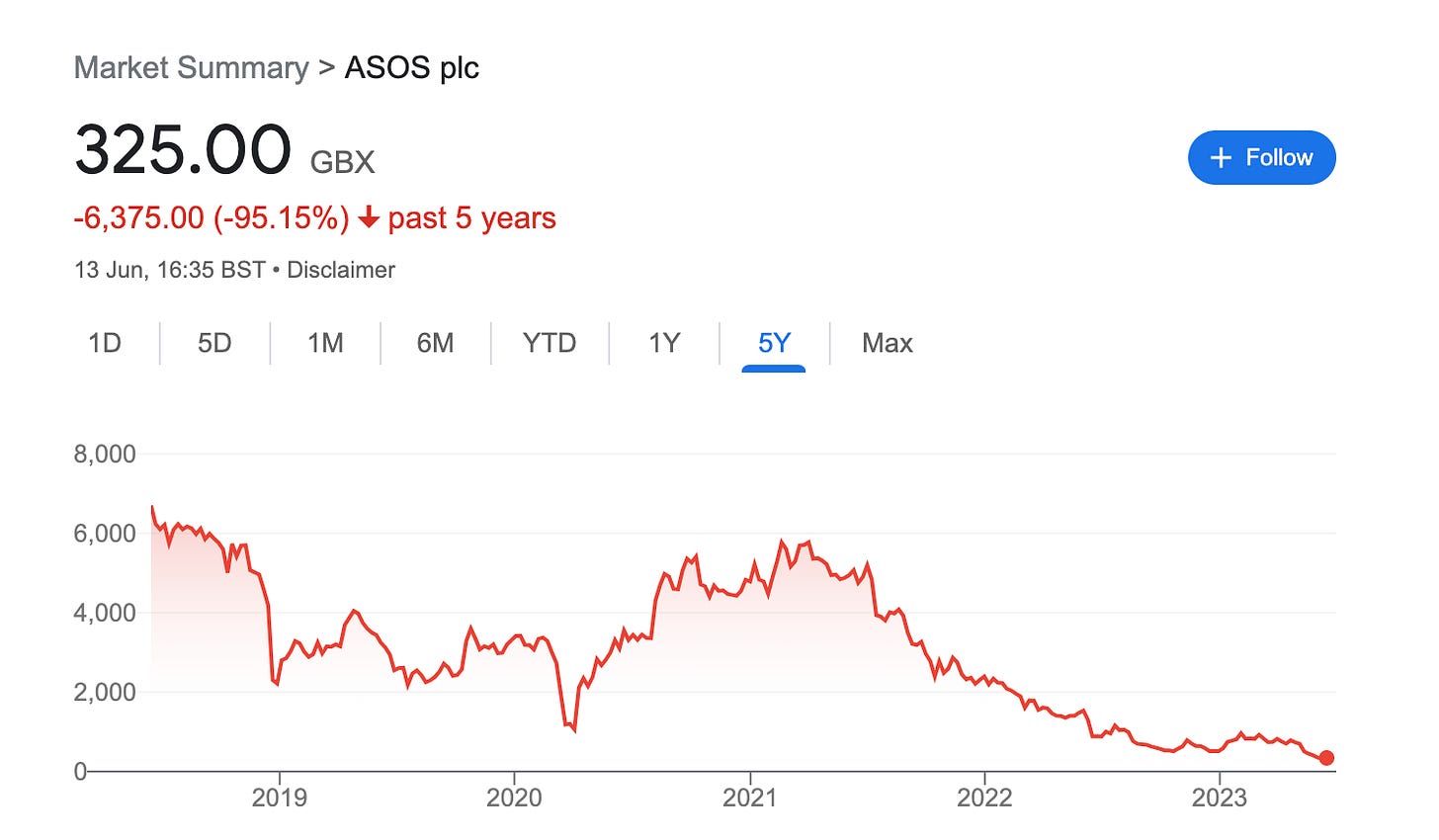the fall of asos
where did they go so wrong, and can they fix it?
I find it so hard to believe that ASOS could fail. The site has been online almost as long as I have, one of the only forward-thinking retail companies when we all pivoted to online shopping. I found so many great bloggers through their Insider programme, influencing me to buy Air Max 95s and adopt a palette of almost exclusively black, white and grey (very chic) while I was at university. It even launched careers — look at the amazing success of Megan Ellaby! The brand has undeniably had a huge impact on U.K. girlies in the past decade.
It was reported this week that Frasers Group, a high street major player owned by Mark Ashley, had boosted their share of the company to 9.9%. This created speculation that there is a big change in the pipeline for ASOS, and Ashley wants to ensure his voice is heard as one of the three largest investors in the business. ASOS hasn’t been having the best time post-pandemic, reporting a £291 million loss in the six months prior to March. Could this be the moment that ASOS goes under?
I’ve seen a few theories about why ASOS has fallen out of favour in recent months. Some people have cited the reopening of the high street post-lockdowns as a key factor — however I’m not sure about this one. I don’t know if you’ve walked down a local high street lately, but to me, they don’t look like they’re stealing business from anyone. Oxford Street and Westfield are looking pretty full on a Saturday, but when you look country-wide and see empty storefront after empty storefront, I don’t think we can blame the not-so-thriving high street for ASOS’s decline.
The main thing I hear in passing is the quality drop-off; “ASOS is trying to be like Shein,” is a sentiment being shared all over Twitter right now. When shopping on the site, you’re entering a quality lottery in a way you didn’t used to be. This is a trend I’ve noticed across a lot of fast fashion brands in the past few years; so many things you buy feel a lot cheaper than they used to, and don’t last as long. Part of this is the Shein effect, and how Shein has changed clothing production in general, but I wonder if it’s also connected to supply chain issues and Brexit. I’ve heard that U.K. brands have been struggling with supply chain issues since we left the EU, which, compounded by the global pandemic and inflation, have caused major launch delays for their 2022 and 2023 collections. If this is the case, then it makes sense that a U.K. company with an extensive and popular set of brand-name ranges would be struggling more than competitors like Zara or H&M, both of which are based in Europe.
With supply chains in mind, some say they have also bitten off more than they can chew by expanding too aggressively. In October 2022, the new ASOS boss José Ramos Calamonte described their recent strategy as, “excessively capital intensive, too complex and overstretched globally.” It sounds like the U.K. operation wasn’t the only part of the brand suffering from distribution issues, and I’m sure this has had a knock-on effect across the whole company.
I’ve also heard people say that Gen Z have moved away from buying fast fashion, and so ASOS is taking the hit as young people were their primary customer. Gen Z do shop second hand more, and this move has been heavily influenced by affordability — remember, all of them are still under twenty-six, the oldest of which are one of the most likely groups in society to be feeling the impact of the cost of living crisis. However, I had a suspicion it wasn’t as black and white as ASOS losing all of their young customers to Vinted, Depop and eBay.
So I surveyed my Gen Z audience on Instagram, and while many of them said they shop almost exclusively second-hand, to my surprise, some of them do shop at ASOS. They said they like the convenience and the size range, however for some it was a last resort, and they tend to check Zara, H&M and other high street stores first. One person said, “used to get loads from ASOS but the quality has gone so downhill I don’t trust her anymor” which I think, assuming the character limit were extended to fit that final letter, summarises the sentiment in the replies pretty well.
ASOS themselves have cited another customer issue when chalking up their losses; apparently the responsibility rests with just 6% of their customers. This 6% (which is around 1.5 million customers) make large orders on Klarna and then return most of the items. How dare the people only keep the clothes they want! To me, this feels like an issue worth solving instead of scapegoating. Why are customers shopping like this (in a way that I think is totally reasonable — it makes sense that people want to try before they buy) and how can ASOS adapt to accommodate this buying behaviour?
I’ll be honest, I haven’t shopped on ASOS in months. So for research, I went on the site and had a scroll. The main thing I noticed when browsing is that there’s a lot of the same. So many pairs of nearly-identical black biker shorts, denim skirts and mesh co-ords. Where is the ASOS I used to go to for inspiration? Sorry to bring this up again but where are the Insiders?! If ASOS is trying to appeal to Gen Z to stay afloat, you can’t tell — it looks like the design team haven’t met any of them. The inclusive ASOS own brand ranges like Hourglass, Curve and Petite that set them apart from other retailers are looking pretty bare too. The most interesting pieces are the ones made by concession brands stocked on the site. It’s a bleak picture.
However, I can’t shake the feeling that despite all of this, ASOS will pull things back. They are such a powerful brand in the U.K., with owners who have a reputation of resuscitating failing brands over giving them the kiss of death and spending the pension pot, à la Phillip Green with BHS and Topshop. Their core offering is great; the convenience of finding all of your favourite brands in one place, in the size you need. I want them to embrace those customers who are making extensive returns and create a solution to help them shop. ASOS thrived when they took risks and thought ahead, sartorial problem-solving for twenty-somethings who didn’t know what they wanted yet. If they can get back to that place, I think the future is optimistic.




